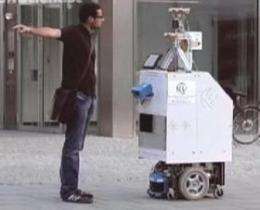May 14, 2009 weblog
Robot Navigates City by Asking for Directions

(PhysOrg.com) -- ACE the robot was sent on a mission by its German inventors: to find its way to the Marienplatz in the center of Munich, about 1.5 km away from its starting point at the Technical University of Munich (TUM). Since ACE (Autonomous City Explorer) doesn't have a map or GPS system, it could only ask for directions from people passing by.
About 5 hours later, after interacting with 38 people, ACE reached its destination. The researchers, led by Martin Buss at TUM, said that ACE was making good progress until it came to a busy pedestrian area and 21 curious onlookers stopped to investigate and talk to the robot. The experiment shows that robots can take advantage of human intelligence when navigating a new environment, which is often a challenging task.
Like a lost human, ACE approaches a nearby human, which it detects by motion and upright posture. As it rolls toward the person, the robot's "head" turns to face them, displaying a touchscreen and an animated mouth. A speaker operating in sync with the mouth asks the person to touch the screen if they want to help. The speaker then asks the person to face the robot and point in the correct direction, which ACE detects by posture recognition software. ACE then says, "Thank you," and heads off.
ACE was given wrong directions once, which it had to follow until it reached an obstacle and needed to ask for new information. The new directions put ACE back on track, but the researchers are currently working on a system to check information from humans for plausibility to avoid wrong directions.
Teaching robots to communicate with humans in these types of situations will be important for real-world situations, such as navigating burning buildings, researchers explain. Letting robots loose in the real world is also helpful for "training" people to become used to their presence, which will likely be more common in the future.
More information: Andrea Bauer, et al. "The Autonomous City Explorer: Towards Natural Human-Robot Interaction in Urban Environments." International journal of Social Robotics. To be published.
via: New Scientist
© 2009 PhysOrg.com


















